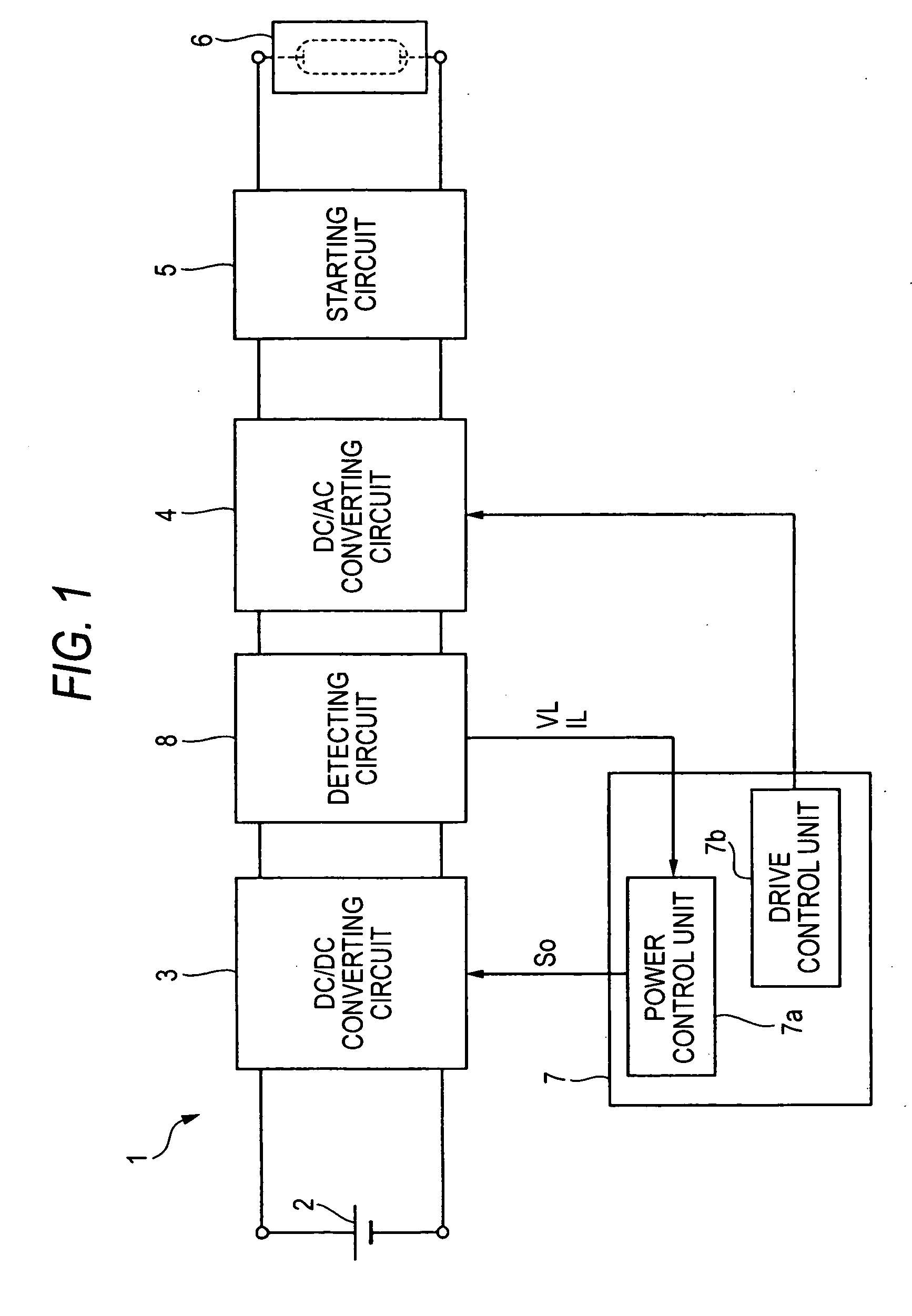Lighting circuit
a light-emitting circuit and circuit technology, applied in the direction of electric variable regulation, process and machine control, instruments, etc., can solve the problems of electromagnetic noise generating during noise generation, unstable status of discharge tubes, and inability to grasp the correlation characteristics between lamp voltages and optical outputs, etc., to achieve the effect of suppressing radiation nois
- Summary
- Abstract
- Description
- Claims
- Application Information
AI Technical Summary
Benefits of technology
Problems solved by technology
Method used
Image
Examples
first exemplary embodiment
[0092]Next, description is made of the second discharging unit 42 according to a first exemplary embodiment of the present invention. FIG. 7 is a circuit diagram showing an arrangement of the second discharging unit 42 according to the first exemplary embodiment of the present invention. The discharging unit 42 shown in FIG. 7 includes a diode 45 and resistor elements 46 and 47.
[0093]An anode of the diode 45 is connected to the capacitor 23, and a cathode of the diode 45 is connected to one terminal of the resistor element 46 and one terminal of the resistor element 47. The other terminal of the resistor element 46 is connected to a first power supply line 48, and the other terminal of the resistor element 47 is connected to a second power supply line (for example, ground line) 49.
[0094]A voltage is generated on the first power supply line in connection with a lamp voltage applied to the discharge tube. Concretely speaking, when an input DC voltage is turned ON, such a voltage which...
second embodiment
[0103]Next, a description is made of a second discharging unit 42A according to a second exemplary embodiment of the present invention. FIG. 10 is a circuit diagram showing an arrangement of the second discharging unit 42A according to the second exemplary embodiment of the present invention. The second discharging unit 42A shown in FIG. 10 can be employed instead of the second discharging unit 42 of the first exemplary embodiment. The second discharging unit 42A is different from the second discharging unit 42 as to the arrangement which is not provided with the resistance element 47 in the second discharging unit 42.
[0104]The second discharging unit 42A provides one discharging path (namely, discharging path constituted by diode 45 and resistor element 46) for the capacitor 23 in response to such a condition that the input DC voltage is turned OFF. Also, in the lighting circuit of this second exemplary embodiment, a similar merit to the lighting circuit of the first exemplary embo...
third exemplary embodiment
[0105]Next, description is made of a second discharging unit 42B according to a third exemplary embodiment of the present invention. FIG. 11 is a circuit diagram showing an arrangement of the second discharging unit 42B according to the third exemplary embodiment of the present invention. The second discharging unit 42B shown in FIG. 11 can be employed instead of the second discharging unit 42 of the first exemplary embodiment. The second discharging unit 42B is different from the second discharging unit 42 as to the arrangement which is not provided with the resistance element 46 in the second discharging unit 42, and is different from the second discharging unit 42 as to the arrangement in which the cathode of the diode 45 and one terminal of the resistor element 47 are connected to the first power line 48.
[0106]In the first exemplary embodiment, when the input DC voltage is turned OFF, the first power supply line 48 is grounded. In this third exemplary embodiment, when the input ...
PUM
 Login to View More
Login to View More Abstract
Description
Claims
Application Information
 Login to View More
Login to View More - R&D
- Intellectual Property
- Life Sciences
- Materials
- Tech Scout
- Unparalleled Data Quality
- Higher Quality Content
- 60% Fewer Hallucinations
Browse by: Latest US Patents, China's latest patents, Technical Efficacy Thesaurus, Application Domain, Technology Topic, Popular Technical Reports.
© 2025 PatSnap. All rights reserved.Legal|Privacy policy|Modern Slavery Act Transparency Statement|Sitemap|About US| Contact US: help@patsnap.com



